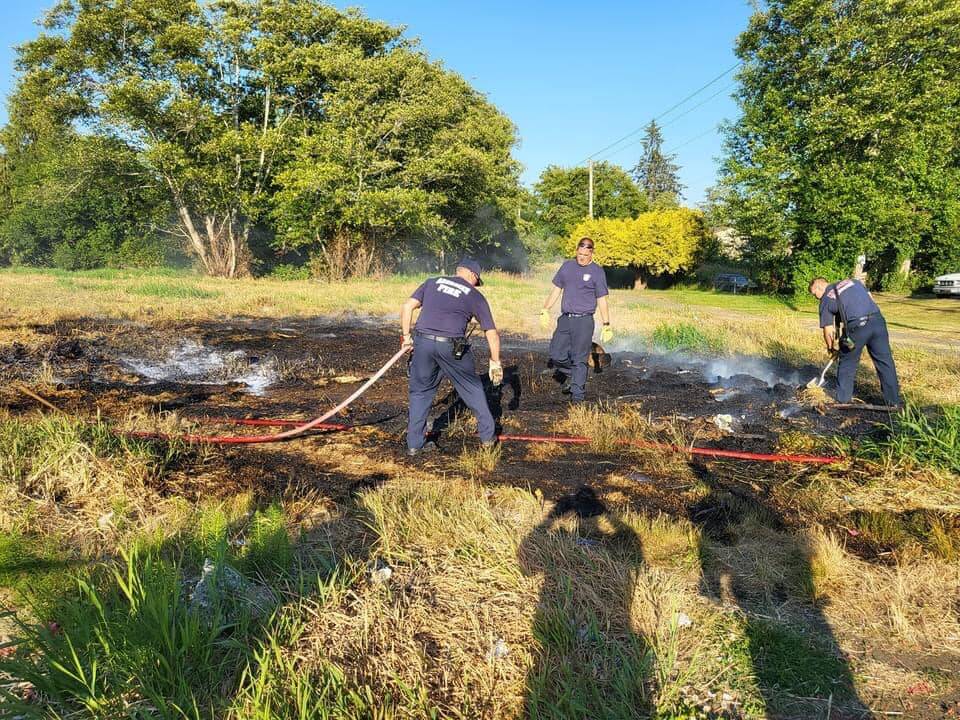Despite a slew of firework-induced grass blazes, municipal fire departments survived the holiday weekend mostly unscathed and without related injury. But as other wildfires sparked and grew in the area, hot and dry conditions led officials to tighten burning restrictions.
With the current volatility of vegetation, Aberdeen enacted a ban on all outdoor burning within the city limits. As of July 5, recreational campfires, charcoal and wood burning are prohibited. Propane stoves and grills, as well as portable gas-burning fire pits are still allowed.
The Grays Harbor County Fire Marshal’s Office enacted the same ban Wednesday, citing continued warm, dry conditions. The ban will continue “until conditions moderate.”
A wildfire started early Wednesday morning in the Capital State Forest and burned four acres southwest of McCleary as of the afternoon. The Department of Natural Resources sent crews to the Rock Candy Mountain area of the forest to battle the blaze, labeled the “Bozy” fire, which remained not contained as of Wednesday afternoon, said Janet Pearce, communications manager for the DNR.
Pearce said the cause of the Bozy fire has not been determined.
Most of the department’s resources were attributed to a large brush fire in Mason County, near Shelton. That blaze, called the McEwan fire, began Tuesday afternoon, threatening homes and forcing some to evacuate. It had burned over 250 acres as of Wednesday morning, and was completely lined — although not contained — by heavy equipment.
On Wednesday, the National Weather Service in Seattle issued a Red Flag warning for much of Southwest Washington, including East Grays Harbor County, as well as the western parts of Mason and Thurston counties. The warning is an indication of “critical” fire conditions, according to the NWS.
After a wet April left feet of snowpack in the mountains, May was one of the driest in decades, and June followed with little precipitation, while hot weather dried out fuels on the ground.
The Red Flag Warning also indicates a potential air quality risk. Air quality monitors Wednesday showed “moderate” air quality close to the coast, but “unhealthy” air east of Elma and into Mason County.
Hazy air Wednesday was also partly the aftermath of the Fourth of July holiday.
On Tuesday, fireworks caused nine incidental fires prompting response from the Aberdeen or Hoquiam fire departments. That response — and the fact that fires burned mostly in grass — kept Aberdeen “fairly unscathed” following the collision of unusually dry weather and a holiday centered around explosives, said Aberdeen Fire Chief Dave Golding.
Lighting fireworks is legal within the city of Aberdeen on the Fourth of July only, but not otherwise. In Hoquiam, it was legal on July 3 and 4.
Hoquiam crews doused a few small grass fires Tuesday, none bigger than about 20 feet across, said Hoquiam Fire Chief Matt Miller. On another call they extinguished a small, smoldering refrigerator near O and 4th streets, where an individual said they had taken the appliance outside, stuffed it with a lit firework and closed the door.
In the coming weeks, municipal fire departments will report statistics about fire-related incidents to the state Fire Marshal’s Office.
Those remained relatively few, even on the coast, where people packed in to celebrate the potent holiday.
Ocean Shores fire rigs up and down the beach greeted beachgoers to educate about proper firework use, and strung ropes to create a 100-foot buffer from the dune grass. No major dune fires occurred, said Ocean Shores Fire Chief Brian Ritter. Fireworks were, however, considered a potential cause of a structure fire that filled a garage in the early morning hours Monday.
Ritter said large metal dumpsters at beach entrances helped mitigate incidental blazes by containing the smoldering remnants of spent fireworks. He said the department didn’t receive any calls for injuries caused by fireworks.
That was also true for the South Beach Regional Fire Authority. In Tokeland, boat flares were the culprit, which started a blaze on dry grass that stretched to a 165-by-65-foot area. Fireworks caused a few other minor fires as well, according to SBRFA Public Information Officer Coleena Curry.
Now, it’s the fireworks still sitting in garages and on porches that pose the greatest fire threat, said Aberdeen’s Chief Golding. He said people sometimes light leftover explosives in the weeks after the holiday, which can lead to more fires.
Contact reporter Clayton Franke at 406-552-3917 or clayton.franke@thedailyworld.com.



